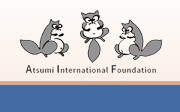SGRAかわらばん
エッセイ387:マックス・マキト「マニラ・レポート2013年夏」
2013年8月23日、フィリピン大学工学部にて、第16回日比共有型成長セミナー「都会・農村の格差と持続可能な共有型成長」が開催された。
午前8時45分、予定通りフィリピンと日本両国の国旗掲揚で開会した。日の丸は在フィリピン日本大使館から借り、両国の国歌は、英語訳のついたものをYouTubeからダウンロードした。今年の3月のSGRAかわらばん(エッセイ368:マニラ・レポート2013年冬)でも報告したように、本セミナーを共同で主催する団体の2つの国、フィリピンと日本の国旗掲揚と国歌演奏を行うことは、本セミナーの顧問である東京大学の中西徹教授からヒントを得て、フィリピン人で構成されたセミナー実行委員会で私が相談した結果である。ご存知のように、第2次世界大戦の最後に、マニラはベルリンとスターリングラードと並べられるほど壊滅的な破壊を被った。他の東南アジアの都市では、日本軍は比較的早く降伏したのに、なぜかフィリピンでは徹底抗戦をし、大勢の地元住民が巻き込まれた。実行委員会で相談した時、数人の委員が当時自分の家族が日本軍から受けた経験を分かち合ってくれた。私の提案は拒否されるのではないかと思ったが、最後には、全員一致で受け入れてくれた。「あの戦争は忘れてはいけないが、それを乗り越えて前に進まなくては」と。
中西先生が、参加者の誤解を招かないように、この国旗掲揚の意味を、開会挨拶で感動的に語ってくださった(下記参照)。日本大使館から日の丸の貸し出し許可が下りたので、中西先生と日の丸を受け取りにいく時に、大使にご挨拶をしたいと伝えたところ、卜部敏直大使は中西先生のために夕食会を開いてくださった。実行委員会のメンバー数人も一緒に招待され、大使公邸でマニラで一番美味しい和食をご馳走になった。
今回のセミナーは様々な点で今までの記録を更新した。参加者(200人強)、報告(25本)、協力(在フィリピン日本大使館、フィリピン高等教育委員会)、協賛(鹿島フィリピン、農業訓練所、マリア エズペランザ・B・ヴァレンシア&アソシエイツ、ダニエル・B・ブリオネス建設、フィリピン建築家連合)の数が倍増した。皆さんのご支援とご協力に心から御礼を申し上げたい。そして、実行委員たちが本当によく頑張ってくれたことに感謝したい。企画に協力してくれたフィリピン大学建築学部、フィリピン水と衛生センター、元日本国文部省奨学生同窓会、そしてフィリピン大学工学部(とくに機械工学部)にも感謝の意を表したい。
セミナーのテーマは「都会・農村の格差と持続可能な共有型成長」で、5つのブロックに分かれた。「持続可能な共有型成長(その他)」(ブロック1)、「都会・農村のコミュニティにおける社会サービスと生活」(ブロック2)、「持続可能な農業」(ブロック3)、「持続可能な都市」(ブロック4)、「都会の緑とグレー」(ブロック5)である。各ブロックで、平均5人の発表者から各15分の報告があった。合計26本の報告は一日がかりであった(最終的なプログラムは下記リンク参照)。フィリピンは丁度雨季で、セミナーが開催された週はフィリピンの各地で洪水がおこり、キャンセルした報告者や参加者もあった。しかし、実行委員会の懸命な努力により、220人もセミナーに参加してくれた。
名前を出さないのは報告者に対して申し訳ないが、全ての報告についてここで語りきれないので、関心のある読者はぜひ下記リンクより論文要旨をご参照ください。どの報告も、私達が目指すフィリピンのためのKKK(効率・公平・環境)を掲げたものである。ブロック1では、共有型成長KKKに関する定義が取り上げられた。「幸せ」、「環境倫理」、「日本から学んだ共有型成長」というやや広範なものから、フィリピン人が好む「モールに行くこと」やアキノ政権の「健康政策」という具体的な事例まで語られた。ブロック2では、水や衛生を地方に普及させるWASH(Water Sanitation and Health 水に関する衛生と健康)や、高原で母なる自然と調和するシステムを営んでいるKISS (Kapangan Indigenous and Sustainable Systems カパンガン地区における土着かつ持続可能システム)プロジェクトを中心に報告が行われた。お弁当のランチを挟んでブロック3では、ネグロスで実施されている事業を中心に議論が進められた。この事業については僕がDIRI(Downstream Integrated Radicular Import-Substitution 下流統合型幼根的輸入代替)モデルと命名し、研究を続けている。ブロック2と同じくこのブロックでも持続可能な共有型成長のための試みが語られたが、WASHは基本的にPCWSという非営利団体主導、KISSは農地改革省主導、DIRIは民間企業主導と、多様な形がある。ブロック4ではいかにマニラが都市集中型の発展から離れるかという主旨で、他の地方や国(オランダ)の持続可能なモデルが紹介された。同時に、東アジアにおけるフィリピンの戦略的な立地活用についても議論が進められた。ブロック5では、都会の緑とグレーの両側面についての報告があった。前者では、自然が重視されたモールや公共のスペースや都会型の農業がテーマだったが、後者では、都会のゴミは貧しい人々によって処理されているが、その人々を社会の公的な部分に取り入れる重要性が訴えられた。
会場から飛び込んできた質問があった。「あなたはフィリピンにおける共有型成長の実現をどう展望しているか、どのように実現できるかを聞かせてください。」
僕は、過去数年間製造業を、そして近年は農業を通じて、フィリピンの共有型成長へ貢献する道を探ってきた。中小企業・労働者・東アジアと成長が共有できそうなフィリピンの製造業や、KKKを実現できそうな持続可能な農業の可能性を探ってきた。そして、これらの部門を支援・指導する国家戦略がなければ、この可能性を実現することはできないという結論に至っている。僕たちが色々頑張ってみても、あまり進展がない感じである。というのは、フィリピン社会は、海外出稼ぎ者の送金に依存する深刻な病に掛かっている。フィリピン政府が、困難な産業・農業発展戦略を実施しなくても、海外出稼ぎ者から準備外貨が送金される。だから、この質問に対して明るい展望をなかなか描けない。
このように答えざるをえないはずであったが、このセミナーの2週間前に、僕はフィリピンにとって新しい道を発見した。そのきっかけは、国士舘大学の平川均教授、名古屋工業大学の徳丸紀夫教授、創価大学の遠藤美純博士によるフィリピンIT産業の調査である。1週間、IT産業の関係者とのヒアリングを行い、訪問中の皆さんと議論したお陰で、フィリピンIT産業には、上述したような製造業や農業の潜在力を引き出すダイナミズムが十分にあることに気付いた。フィリピンでも共有型成長の展望が明るくなったという気がする。
僕の発表の時に、僕の方から質問を投げかけた。「我々が日本から学べるものに関心がある人?」会場の3分の2ほどが挙手してくれた。手を挙げていない人々よ、これから僕が日本から学んだ共有型成長についてお話ししましょう。日本からいかに学べるか、経済学の視点から説明しましょう。この15分間の話で納得できない方のために、今、「フィリピンのために日本から学ぶ共有型成長」という本のシリーズを執筆しています。
今度のマニラ訪問で、意気投合した仲間達とその本の共著を決めた。その仲間が、いつ出版するのかと聞かれた時に、「5年前(に出版すべきだった)」と即答した。彼はフィリピン政府の政策立案・実行と多くの開発プロジェクトに関わっているからであろうか、この研究の重要性をすぐ理解してくれた。数年間、友人の経済学者に共有型成長の重要性を訴えてきたが、従来型の経済学(つまり市場万能主義)はフィリピンでも根強いらしい。この本にマニラ・セミナーのビションを詳細に書き、従来型と違う経済学をフィリピンに紹介しようと思っている。
この夏、フィリピンで大きなエネルギーをいただいた。第17回日比共有型成長セミナーは、来年の2月にマニラで開催する。「早すぎない?」と悲鳴をあげた実行委員もいたが、幸い20人以上の委員が、フィリピンのためのKKKという我々の使命を理解してくれている。第17回目のマニラ・セミナーは日本の建国の日、2月11日に開催する予定である。
関連リンク等
3.セミナープログラム (又はSGRAセミナー・レポート、まだ作成中)
4.発表書類
7. 中西徹教授の国旗と国歌に関する挨拶文
■ NAKANISHI, Toru “On Sharing the National Flag and National Anthem”
It is my great honor to be given a chance to talk about sharing and respecting the National Flag and National Anthem between the Philippines and Japan as a Japanese. The idea of this opportunity comes from an informal discussion with Dr. Max, Ferdinand Maquito, Program Organizer of this conference.
Frankly speaking, however, I could say that I have not loved HINOMARU and KIMIGAYO for a long time. I think many Filipinos may be surprised to hear this, but such a feeling is not so unusual among the Japanese people. Such tendency may come from the stance of mass media or the elementary and secondary level education in Japan. Some of us insist that HINOMARU and KIMIGAYO were symbols of the militarism in Japan during the World War II, so that respecting them so much will call back such militarism.
Indeed, the Japanese invasion caused huge damages to the other Asian countries like the Philippines. When I was a high school student, I read Without Seeing the Dawn, translated in Japanese, written by Stevan Javellana. This book inspired me to study the Philippine society. In this book it is eloquently described how the Japanese invasion violently changed the peaceful and happy days in a charming village in Panay Island into cruel and hopeless nights.
On the other hand, many Japanese youth were forced to serve in the so-called Kamikaze suicide squad that executed the suicide attack on the US warships, even if they did not want to die in such manner. Even as the bereaved families tried to understand the tragic loss of their sons, they have been condemned for long time after the War as if their sons were willing offenders. The ordinary people, mga tao, always lose loved ones in all wars everywhere.
From the historical point of view, it is true that the World War II had been a nightmare in the long history of Japan. If we, Japanese, really understand the history of the nightmare, none of us will repeat or participate in such tragic and sad mistakes ever. HINOMARU and KIMIGAYO were not created for the World War II but had existed since the Meiji or Edo era during the 19th century. Our history of invasions of the Asian countries has to be understood and accepted as our serious mistakes which disgraced the long history of Japan.
Furthermore, to tell the truth, I have had a basic question: can Japan really pay due respect to the national flag or the national anthem of another country, if she does not pay due respect to those of her own country? Such a question was elicited by one of my experiences in the Philippines about 5 years ago. (By the way, as introduced I have been coming back and forth to the Philippines more than 30 years now.)
I have been involved in some scholarship program for the students living as informal settlers in Malabon since 2006. The aim of this program is to assist students with good grades in the early high school level to take and pass the entrance examinations of the high standard universities, like the UP, and to assist them until their university graduation. About 5 years ago, I went to register some of my scholars for the entrance examination in a private university. I was doing this task for my wards, because their parents did not have enough money to do so.
After I queued up for long line I was finally in front of the registration window to submit the registration forms. I could get my turn at last. However, at this moment, the officer suddenly stopped working. I could not understand what happened to her and asked her why. Then she pointed to the window behind me without saying anything. When I looked back, everyone was silent in the room and were looking at only one thing: the national flag raising with the accompanying singing of the Philippine National Anthem. Immediately, I also paid due respect to the occasion. To pay due respect to the national flag and the National Anthem is very common everywhere in the world. This scene, however, is rarely seen in Japan! This was a very valuable experience for me, because I confirmed that Japan has not shared such an inspiring global standard.
Both HINOMARU and KIMIGAYO already existed long before the World War II started. If the Japanese still think that they are so sinful and therefore scarlet with shame, there must be a strong movement to change the National Flag and the National Anthem in Japan. However, we have not found such movement in Japan until now. I think all Japanese accept HINOMARU and KIMIGAYO positively or negatively. If one says this proposition is not right, I suppose that he would not face up to the history of Japan or he would like to get the absolution for the sins of the World War II by disguising to hate them.
Based on the above narration, the meanings for me as a Japanese of the honor to share the Japanese National Flag and National Anthem with Filipinos are the following three points: First, HINOMARU and KIMIGAYO continue to warn us against militarism. It can be said that for most of us Japanese to accept HINOMARU or KIMIGAYO gives us some pains to some degree or another. In general, Japanese have a feeling that to positively accept HINOMARU or KIMIGAYO means to have an abnormal thought, though to negatively accept them is not. I am confident, however, that we need some more positive deed, that is to say, to accept the whole of our history by squarely or directly confronting our stigma. HINOMARU and KIMIGAYO show our history itself. They always continue to remind us they are symbols of our long history and yet warn us of our historical events and warn us against futile and destructive military adventures.
The second point concerns a global standard of social custom. According to my understanding, there are no countries where many people have a negative image on their own National Flag and their own National Anthem, except Japan. I believe that we should pay due respect to the social custom based on historical traditions. HINOMARU and KIMIGAYO have a long history as repeatedly mentioned. Therefore, if I do not pay due respect to HINOMARU and KIMIGAYO, I must have not a global standard but a double standard. I am confident, finally, that the Japanese should pay due respect to HINOMARU as our National Flag and KIMIGAYO as our National Anthem.
Finally, all the program board members willingly consented to our, sort of test, for jointly honoring both our countries by this gesture through the initiative of Dr. Max. I know the relatives of many of you have grievous experiences similar to those described in Without Seeing the Dawn. On this point, the word “absolve” in a Catholic sense to which Dr. Max referred is very impressive to me. Here I confirm to be determined that Japan would never repeat the mistake in the World War II. Though our trial balloon today is very small step, I feel confident that it will give us a further push to fostering deeper friendship between the Philippines and Japan. Thank you very much for your kind attention.
(Professor, The University of Tokyo)
英語版エッセイはこちら
————————–
<マックス・マキト Max Maquito>
SGRA日比共有型成長セミナー担当研究員。SGRAフィリピン代表。フィリピン大学機械 工学部学士、Center for Research and Communication(CRC:現アジア太平洋大学) 産業経済学修士、東京大学経済学研究科博士、アジア太平洋大学にあるCRCの研究顧 問。テンプル大学ジャパン講師。
————————–
2013年9月25日配信






